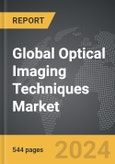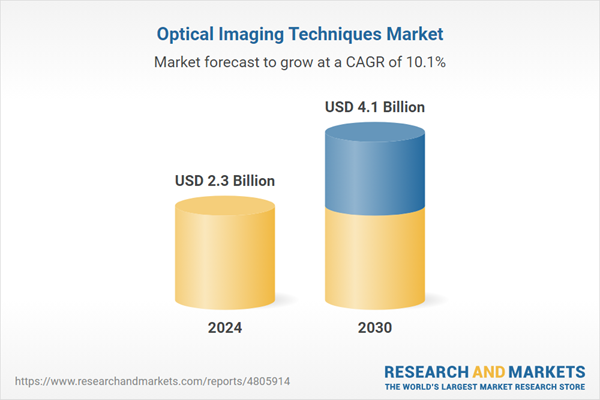The global market for Optical Imaging Techniques was valued at US$2.3 Billion in 2024 and is projected to reach US$4.1 Billion by 2030, growing at a CAGR of 10.1% from 2024 to 2030. This comprehensive report provides an in-depth analysis of market trends, drivers, and forecasts, helping you make informed business decisions. The report includes the most recent global tariff developments and how they impact the Optical Imaging Techniques market.
The field of optical imaging has seen significant technological advancements that have expanded its application and improved its efficacy. Recent developments include the integration of AI and machine learning algorithms that enhance image analysis and interpretation, allowing for faster and more accurate diagnostics. For instance, AI-enhanced imaging software can automatically detect abnormalities in retinal scans or identify cancerous cells with high precision. Additionally, advancements in molecular imaging have introduced new fluorescent and bioluminescent probes that are more sensitive and specific, enabling earlier detection of diseases at the molecular level. These innovations not only improve clinical outcomes but also reduce healthcare costs by facilitating early diagnosis and reducing the need for more invasive tests. The move towards personalized medicine has further propelled the use of optical imaging, as it can provide detailed information about individual patients' disease states, helping to tailor treatments to their specific conditions.
The growth in the optical imaging market is driven by several factors, including the increasing prevalence of chronic diseases, technological advancements in imaging systems, and rising demand for non-invasive diagnostic procedures. As the global population ages, there is a corresponding increase in conditions such as cancer, cardiovascular diseases, and neurological disorders, all of which require precise imaging for effective management. Technological innovations that offer enhanced image clarity, depth resolution, and data analysis capabilities make optical imaging a preferred choice among healthcare providers. Additionally, there is a growing consumer preference for non-invasive and pain-free diagnostic methods, which further boosts the demand for optical imaging solutions. The expansion of healthcare infrastructure across emerging markets and increased healthcare spending also contribute to the growth of this market. Moreover, the ongoing research and development activities focusing on improving the sensitivity and specificity of optical imaging modalities ensure continual advancements in this field, keeping pace with the growing healthcare needs and expectations. Together, these factors ensure a dynamic expansion of the optical imaging market, making it an indispensable tool in modern medical practice and research.
Segments: Technique (Optical Coherence Tomography, Hyperspectral Imaging, Near-Infrared Spectroscopy, Photoacoustic Tomography); Therapeutic Type (Oncology, Ophthalmology, Neurology, Cardiology, and Other Therapeutic Types); and End-Use (Hospitals & Clinics, Research Laboratories, Pharma & Biotech).
Geographic Regions/Countries: World; United States; Canada; Japan; China; Europe (France; Germany; Italy; United Kingdom; and Rest of Europe); Asia-Pacific; Rest of World.
The analysts continuously track trade developments worldwide, drawing insights from leading global economists and over 200 industry and policy institutions, including think tanks, trade organizations, and national economic advisory bodies. This intelligence is integrated into forecasting models to provide timely, data-driven analysis of emerging risks and opportunities.
Global Optical Imaging Market - Key Trends & Drivers Summarized
Optical imaging is a technique used to visually capture the anatomy and molecular processes of living organisms. It uses light and special properties of photons to obtain detailed images of organs, tissues, and cells, which can be used for medical diagnostics and research. This non-invasive method employs various forms of light such as visible, ultraviolet, and infrared, and technologies including fluorescence and bioluminescence imaging. Optical imaging systems, such as optical coherence tomography (OCT), confocal microscopy, and hyperspectral imaging, offer the advantage of high-resolution images with minimal risk to the patient. These systems are crucial in fields such as ophthalmology, oncology, cardiology, and neurology, where detailed and precise images are essential for diagnosis, monitoring, and treatment planning. Additionally, optical imaging is used extensively in preclinical research and clinical trials, providing researchers with valuable insights into complex biological processes without the need for invasive procedures.The field of optical imaging has seen significant technological advancements that have expanded its application and improved its efficacy. Recent developments include the integration of AI and machine learning algorithms that enhance image analysis and interpretation, allowing for faster and more accurate diagnostics. For instance, AI-enhanced imaging software can automatically detect abnormalities in retinal scans or identify cancerous cells with high precision. Additionally, advancements in molecular imaging have introduced new fluorescent and bioluminescent probes that are more sensitive and specific, enabling earlier detection of diseases at the molecular level. These innovations not only improve clinical outcomes but also reduce healthcare costs by facilitating early diagnosis and reducing the need for more invasive tests. The move towards personalized medicine has further propelled the use of optical imaging, as it can provide detailed information about individual patients' disease states, helping to tailor treatments to their specific conditions.
The growth in the optical imaging market is driven by several factors, including the increasing prevalence of chronic diseases, technological advancements in imaging systems, and rising demand for non-invasive diagnostic procedures. As the global population ages, there is a corresponding increase in conditions such as cancer, cardiovascular diseases, and neurological disorders, all of which require precise imaging for effective management. Technological innovations that offer enhanced image clarity, depth resolution, and data analysis capabilities make optical imaging a preferred choice among healthcare providers. Additionally, there is a growing consumer preference for non-invasive and pain-free diagnostic methods, which further boosts the demand for optical imaging solutions. The expansion of healthcare infrastructure across emerging markets and increased healthcare spending also contribute to the growth of this market. Moreover, the ongoing research and development activities focusing on improving the sensitivity and specificity of optical imaging modalities ensure continual advancements in this field, keeping pace with the growing healthcare needs and expectations. Together, these factors ensure a dynamic expansion of the optical imaging market, making it an indispensable tool in modern medical practice and research.
Report Scope
The report analyzes the Optical Imaging Techniques market, presented in terms of units. The analysis covers the key segments and geographic regions outlined below.Segments: Technique (Optical Coherence Tomography, Hyperspectral Imaging, Near-Infrared Spectroscopy, Photoacoustic Tomography); Therapeutic Type (Oncology, Ophthalmology, Neurology, Cardiology, and Other Therapeutic Types); and End-Use (Hospitals & Clinics, Research Laboratories, Pharma & Biotech).
Geographic Regions/Countries: World; United States; Canada; Japan; China; Europe (France; Germany; Italy; United Kingdom; and Rest of Europe); Asia-Pacific; Rest of World.
Key Insights:
- Market Growth: Understand the significant growth trajectory of the Optical Coherence Tomography segment, which is expected to reach US$3.2 Billion by 2030 with a CAGR of a 10.0%. The Hyperspectral Imaging segment is also set to grow at 10.1% CAGR over the analysis period.
- Regional Analysis: Gain insights into the U.S. market, valued at $1.1 Billion in 2024, and China, forecasted to grow at an impressive 14.2% CAGR to reach $328.6 Million by 2030. Discover growth trends in other key regions, including Japan, Canada, Germany, and the Asia-Pacific.
Why You Should Buy This Report:
- Detailed Market Analysis: Access a thorough analysis of the Global Optical Imaging Techniques Market, covering all major geographic regions and market segments.
- Competitive Insights: Get an overview of the competitive landscape, including the market presence of major players across different geographies.
- Future Trends and Drivers: Understand the key trends and drivers shaping the future of the Global Optical Imaging Techniques Market.
- Actionable Insights: Benefit from actionable insights that can help you identify new revenue opportunities and make strategic business decisions.
Key Questions Answered:
- How is the Global Optical Imaging Techniques Market expected to evolve by 2030?
- What are the main drivers and restraints affecting the market?
- Which market segments will grow the most over the forecast period?
- How will market shares for different regions and segments change by 2030?
- Who are the leading players in the market, and what are their prospects?
Report Features:
- Comprehensive Market Data: Independent analysis of annual sales and market forecasts in US$ Million from 2024 to 2030.
- In-Depth Regional Analysis: Detailed insights into key markets, including the U.S., China, Japan, Canada, Europe, Asia-Pacific, Latin America, Middle East, and Africa.
- Company Profiles: Coverage of players such as Abbott Laboratories, Inc., Canon, Inc., Bruker Corporation, Agfa-Gevaert NV, FUJIFILM Holdings Corporation and more.
- Complimentary Updates: Receive free report updates for one year to keep you informed of the latest market developments.
Some of the 42 companies featured in this Optical Imaging Techniques market report include:
- Abbott Laboratories, Inc.
- Canon, Inc.
- Bruker Corporation
- Agfa-Gevaert NV
- FUJIFILM Holdings Corporation
- Carl Zeiss Meditec AG
- Canon Medical Systems Europe B.V.,
- Headwall Photonics, Inc.
- BaySpec, Inc.
- Benchmark Electronics, Inc.
- CytoViva, Inc.
- Heidelberg Engineering, Inc.
- ChemImage Corporation
- Cubert GmbH
- FujiFilm VisualSonics, Inc.
Tariff Impact Analysis: Key Insights for 2025
Global tariff negotiations across 180+ countries are reshaping supply chains, costs, and competitiveness. This report reflects the latest developments as of April 2025 and incorporates forward-looking insights into the market outlook.The analysts continuously track trade developments worldwide, drawing insights from leading global economists and over 200 industry and policy institutions, including think tanks, trade organizations, and national economic advisory bodies. This intelligence is integrated into forecasting models to provide timely, data-driven analysis of emerging risks and opportunities.
What’s Included in This Edition:
- Tariff-adjusted market forecasts by region and segment
- Analysis of cost and supply chain implications by sourcing and trade exposure
- Strategic insights into geographic shifts
Buyers receive a free July 2025 update with:
- Finalized tariff impacts and new trade agreement effects
- Updated projections reflecting global sourcing and cost shifts
- Expanded country-specific coverage across the industry
Table of Contents
I. METHODOLOGYII. EXECUTIVE SUMMARYIII. MARKET ANALYSISCANADAITALYSPAINRUSSIAREST OF EUROPESOUTH KOREAREST OF ASIA-PACIFICARGENTINABRAZILMEXICOREST OF LATIN AMERICAIRANISRAELSAUDI ARABIAUNITED ARAB EMIRATESREST OF MIDDLE EASTIV. COMPETITION
1. MARKET OVERVIEW
2. FOCUS ON SELECT PLAYERS
3. MARKET TRENDS & DRIVERS
4. GLOBAL MARKET PERSPECTIVE
UNITED STATES
JAPAN
CHINA
EUROPE
FRANCE
GERMANY
UNITED KINGDOM
ASIA-PACIFIC
AUSTRALIA
INDIA
LATIN AMERICA
MIDDLE EAST
AFRICA
Companies Mentioned (Partial List)
A selection of companies mentioned in this report includes, but is not limited to:
- Abbott Laboratories, Inc.
- Canon, Inc.
- Bruker Corporation
- Agfa-Gevaert NV
- FUJIFILM Holdings Corporation
- Carl Zeiss Meditec AG
- Canon Medical Systems Europe B.V.,
- Headwall Photonics, Inc.
- BaySpec, Inc.
- Benchmark Electronics, Inc.
- CytoViva, Inc.
- Heidelberg Engineering, Inc.
- ChemImage Corporation
- Cubert GmbH
- FujiFilm VisualSonics, Inc.
Table Information
| Report Attribute | Details |
|---|---|
| No. of Pages | 544 |
| Published | April 2025 |
| Forecast Period | 2024 - 2030 |
| Estimated Market Value ( USD | $ 2.3 Billion |
| Forecasted Market Value ( USD | $ 4.1 Billion |
| Compound Annual Growth Rate | 10.1% |
| Regions Covered | Global |









